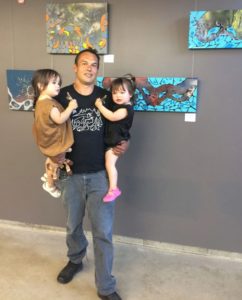Colonization pop culture fusion generates awareness and important discussions through art

By Rick Garrick
THUNDER BAY—Biinjitiwaabik Zaaging Anishinaabek (BZA) artist Shaun Hedican opened his Halftone Empire exhibition on July 1 at the Baggage Building Arts Centre at Prince Arthur’s Landing in Thunder Bay.
“It was really busy,” Hedican says. “I found it interesting that everyone was celebrating Canada Day and all of the art in the [Halftone Empire] exhibition explores these ideas of colonization and genocide.”
Hedican says the exhibition explores themes of colonization using pop culture elements such as George Lucas’ Star Wars.
“More than anything, I wanted to explore the idea in a way that people would be more receptive to instead of just shutting down and ignoring the subject,” Hedican says. “A lot of people imagine the genocide in North America as being the least discussed genocide in history.”
“And I think it is the responsibility of artists to contribute to the discussion or generate discussion as well,” added Hedican.
The Halftone Empire exhibition is Hedican’s first solo exhibition in the Thunder Bay-BZA area since he moved to BZA from Toronto about four years ago. The exhibition runs from July 1-30, 2016.
“I’m hoping to create more awareness of my art in the local area and to give people a chance to view some larger scale pieces that they might not see otherwise in a gallery or at a public event,” Hedican stated.
Hedican has found a different perspective with his art since moving to BZA.
“It certainly challenges me to engage different themes directly rather than simply talking about it from a distance,” Hedican says.
“Sometimes in a larger city you can take a step back from being an Indigenous person and blend into the crowd. But being in one of our communities full-time generates a bit of a different perspective. Often we can see firsthand how our people have been marginalized. Although there is a large Anishinaabe population in areas such as [Prince Arthur’s Landing], we are almost absent. The idea of presence is important to me and is reflected in the work,” continued Hedican.
Hedican invites people to check out his exhibition at the Baggage Building.
“I think that as Anishinaabe people, we should assert our presence and fill space,” Hedican says.
“If we are not present and filling the space with our art or music or culture or language, et cetera, we’re almost consenting to assimilation. I feel we all have to work together to claim the space for ourselves,” expressed Hedican.
Hedican began working full-time in art after he moved to Toronto in 2009.
“I noticed there was a fairly limited Anishinabek presence in a lot of the galleries,” Hedican says. “And in other galleries, the presence was limited to very established artists from previous generations. There was a gap there to be filled, I thought. So I cashed in an RRSP and paid rent and purchased art supplies and started experimenting with my painting.”
Hedican initially developed an interest in art when he was young due to his grandmother Margaret Hedican being a successful artist. He also travelled with his parents to Elders gatherings, ceremonies, and other cultural events, where he learned about the concepts, practices, and spirituality of his people.
“From an early age I was always interested in our culture and being exposed to it in a variety of ways,” Hedican says. “My father, who was not Anishinabe, was an anthropology professor [who] knew our language and was actively involved in exploring Indigenous issues.”
Since moving to BZA, Hedican has been involved in a variety of art projects in Thunder Bay, including screen printing at Lakehead University and spiritual self portraits at Neechee Studio.


